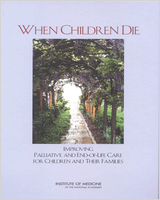begin quote from:
https://www.ncbi.nlm.nih.gov/books/NBK220806/

When Children Die: Improving Palliative and End-of-Life Care for Children and Their Families.
Show detailsA simple child, that lightly draws its breath, And feels its life in every limb, What should it know of death?
William Wordsworth, 1798
In 1999, children aged 0 to 19 accounted for 29 percent, or 77.8 million, of the U.S. population of 272.7 million (U.S. Census, 2001). Reflecting their generally good health, children accounted for only 2 percent of all deaths—about 55,000 compared to more than a half million deaths for adults aged 20 to 64 and 1.8 million for those age 65 and over (NCHS, 2001a).1 Wordsworth's implicit hope is far more a reality today than during the time 200 years past when the poet's two youngest children died.
This chapter summarizes information about the death rates and leading causes of death for children of different ages. It also reviews information about where children die. The discussion begins, however, by briefly putting life-threatening illness and death during childhood in the broader context of child health and illness in the United States. The chapter ends with a short discussion of conclusions and implications for health care providers and policymakers.
CHILDHOOD DEATH IN THE CONTEXT OF IMPROVED CHILD HEALTH
Any discussion of death in childhood and the experience of children and families living with life-threatening medical problems has to be put in the context of child health as it has improved during the last century. First, in the United States, death in childhood is now rare rather than commonplace. Second, causes of death in childhood have changed. Third, children have different patterns of mortality than adults. Fourth, although most children are now healthy, a significant fraction lives with serious health problems.
Death in Childhood Is No Longer Expected
In 1900, 30 percent of all deaths in the United States occurred in children less than 5 years of age compared to just 1.4 percent in 1999 (CDC, 1999a; NCHS, 2001a). Infant mortality dropped from approximately 100 deaths per 1,000 live births in 1915 (the first year for which data to calculate an infant mortality rate were available) to 29.2 deaths per 1,000 births in 1950 and 7.1 per 1,000 in 1999 (CDC, 1999b; NCHS, 2001a).2
This decrease in mortality reflects a century's worth of advances in public health, living standards, medical science and technology, and clinical practice. Many infants who once would have died from prematurity, complications of childbirth, and congenital anomalies (birth defects) now survive. Children who previously would have perished from an array of childhood infections today live healthy and long lives thanks to sanitation improvements, vaccines, and antibiotics. In the United States, the average life expectancy at birth rose from less than 50 years in 1900 to more than 76 years in 1999, due in considerable measure to continuing reductions in infant and child mortality (NCHS, 2001c).
Nonetheless, each year in this country, thousands of parents lose their children to conditions such as prematurity, congenital anomalies, injuries, and diseases such as cancer and heart disease. Thousands more siblings, grandparents, other family members, friends, neighbors, schoolmates, and professional caregivers are touched by these deaths. Instead of being a sad but common family experience, death in childhood now stands out as a particular tragedy, at least in developed nations such as the United States.
Leading Causes of Death in Childhood Have Changed
In 1900, pneumonia and influenza, tuberculosis, and enteritis with diarrhea were the three leading causes of death in the United States, and children under 5 accounted for 40 percent of all deaths from these infections (CDC, 1999a). Today, only pneumonia (in combination with influenza) is among the top 10 causes of death overall or for children. Substantial declines in mortality have continued in recent decades. During the past 40 years, infant deaths due to pneumonia and influenza fell from 314 per 100,000 live births in 1960 to 8 per 100,000 in 1999 (Singh and Yu, 1995; NCHS, 2001b). As infectious disease mortality has declined in significance, unintentional and intentional injuries have emerged as leading causes of death, especially for children past infancy.
In 1960, infant deaths from short gestation/low birth weight and congenital anomalies (described in federal reports as “congenital malformations, deformations, and chromosomal abnormalities”) occurred at rates of 457 and 361 per 100,000 live births, respectively (Singh and Yu, 1995). By 1999, these rates had dropped to 111 and 138 per 100,000, respectively (NCHS, 2001b).
More recently, mortality from sudden infant death syndrome (SIDS), which was first reported as a separate cause of death in 1973, has dropped substantially—by more than a third between 1992 and 1996, with continuing decreases since then (Willinger et al., 1998; NCHS, 2000b). SIDS is still, however, the third leading cause of infant death in this country.
Children Have Different Patterns of Mortality Than Adults
As shown in Table 2.1 (which uses broader age categories than those used later in this chapter) the leading causes of death differ considerably for children compared to adults, especially elderly adults. For infants, the leading causes of death include congenital anomalies (a highly diverse group of malformations and other conditions), disorders related to short gestation and low birth weight, and sudden infant death syndrome. For older children and teenagers, mortality from unintentional and intentional injuries grows in importance. Among adults, as age increases, the relative contribution of injuries decreases, and death rates related to chronic conditions such as heart disease increase sharply. Beginning in adolescence, increasing age also brings increases in causes of death linked to individual behaviors involving diet, exercise, smoking, alcohol use, and similar factors.


No comments:
Post a Comment